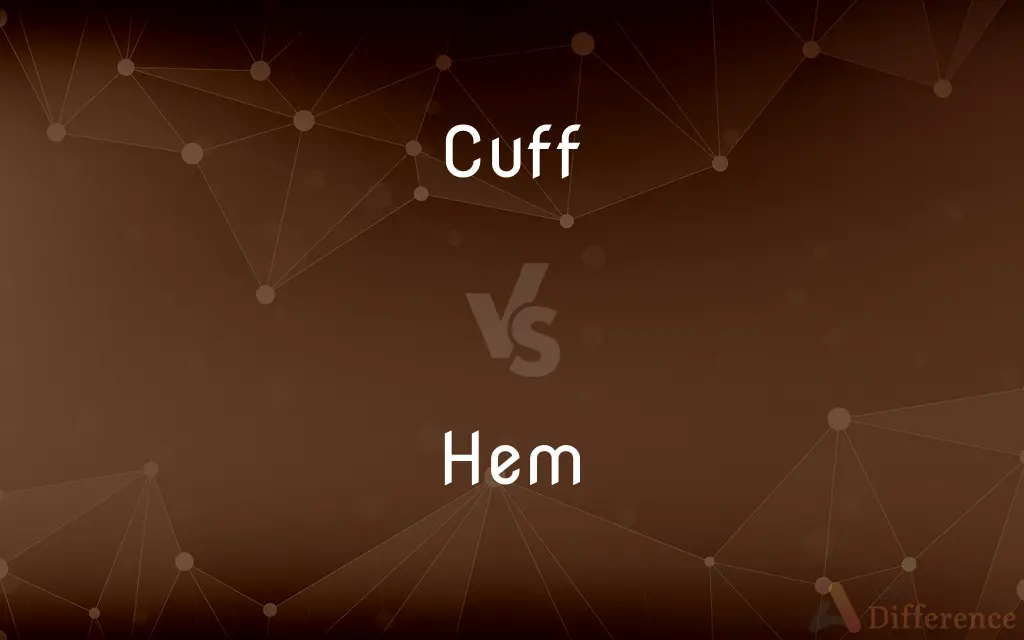Cuff vs. Hem — What's the Difference?
By Maham Liaqat & Fiza Rafique — Updated on March 28, 2024
Cuff refers to the end part of a sleeve or pant leg that is folded or finished off, while hem refers to the edge of a piece of cloth that is folded narrowly and sewn to prevent it from unraveling.

Difference Between Cuff and Hem
Table of Contents
ADVERTISEMENT
Key Differences
While cuffs are specifically related to sleeves and pant legs and often include mechanisms for adjustability or opening, hems are a more universal feature found on many types of clothing and fabric goods. Hemming is a basic sewing technique that applies to virtually any fabric edge, designed to ensure durability and a clean finish. In contrast, cuffs may require more complex construction, including additional layers of fabric or interfacing to maintain their shape and functionality.
The function of cuffs extends beyond merely preventing fraying; they also adjust garment fit and can be stylistic elements, reflecting fashion trends or personal style. For example, French cuffs on a dress shirt are a choice for formal attire, requiring cufflinks for closure. Hemlines, conversely, play a significant role in the style and silhouette of a garment, influencing its overall appearance and the wearer's movement. The length and style of a hem can dramatically alter a garment's formality and functionality.
Both cuffs and hems are essential components in garment construction, each serving to finish off fabric edges with a focus on functionality and aesthetics. However, cuffs are specific to the ends of sleeves and pant legs with potential for intricate designs and adjustments, while hems are a more generalized feature aimed at ensuring fabric longevity and clean lines across a variety of garments.
Cuffs are specific to the parts of clothing that encircle the wrists or ankles, often designed to be tighter than the rest of the garment to secure the sleeves or pants in place. They can be decorative or functional, featuring buttons, snaps, or elastic. For example, the cuffs on a dress shirt or the ribbed cuffs of a sweater add both style and practicality, preventing the fabric from fraying and keeping the sleeves from slipping over the hands. On the other hand, a hem is found at the lower edge of a garment, such as the bottom of a skirt, dress, or curtain, serving a similar purpose of preventing unraveling but applicable to any edge of the fabric. Hems can be simple or elaborate, sometimes including lace or other decorative elements to enhance the garment's aesthetic.
Comparison Chart
Location
End part of sleeves or pant legs.
Edge of any piece of cloth or garment.
ADVERTISEMENT
Function
Secures and decorates wrists or ankles, prevents fraying.
Prevents fabric from unraveling, adds a clean finish.
Design
Can include buttons, snaps, or elastic for adjustment.
Can be simple or elaborate, sometimes with decorative elements.
Construction
Often requires more complex construction.
Basic sewing technique applicable to various fabric edges.
Role in Fashion
Adjusts fit, reflects style and trends.
Influences garment silhouette and formality.
Compare with Definitions
Cuff
The part of a garment at the end of a sleeve or pant leg that is folded over or finished.
He buttoned the cuffs of his shirt before putting on his jacket.
Hem
The edge of a piece of cloth or clothing that is folded and sewn to prevent it from unraveling.
She hemmed the skirt to make it shorter.
Cuff
Reflects personal style or fashion trends.
The wide cuffs of his trousers were a nod to vintage fashion.
Hem
Can be a simple fold or decorated with lace or embroidery.
The lace hem of the dress added a delicate touch.
Cuff
Specific to sleeves and pant legs.
She adjusted the cuffs of her blouse to show off her new bracelet.
Hem
Influences the style and movement of a garment.
The asymmetrical hem of the top added an interesting dynamic to her outfit.
Cuff
Often designed for adjustability and style.
The jacket featured leather cuffs that added a touch of elegance.
Hem
Essential for the durability and finish of the fabric.
A well-sewn hem can significantly extend the life of a garment.
Cuff
Can be elasticated or fitted with buttons or snaps.
The elastic cuffs on the raincoat prevented water from dripping onto her hands.
Hem
Found on various garments and cloth goods.
The hem of the curtain matched the room’s decor perfectly.
Cuff
A cuff is a layer of fabric at the lower edge of the sleeve of a garment (shirt, coat, jacket, etc.) at the wrist, or at the ankle end of a trouser leg. The function of turned-back cuffs is to protect the cloth of the garment from fraying, and, when frayed, to allow the cuffs to be readily repaired or replaced, without changing the garment.
Hem
A hem in sewing is a garment finishing method, where the edge of a piece of cloth is folded and sewn to prevent unravelling of the fabric and to adjust the length of the piece in garments, such as at the end of the sleeve or the bottom of the garment.
Cuff
A fold used as trimming at the bottom of a sleeve.
Hem
An edge or border on a piece of cloth, especially a finished edge, as for a garment or curtain, made by folding an edge under and stitching it down.
Cuff
A band, often having an opening with a button closure, at the bottom of a sleeve.
Hem
The height or level of the bottom edge of a skirt, dress, or coat; a hemline.
Cuff
The turned-up fold at the bottom of a trouser leg.
Hem
A short cough or clearing of the throat made especially to gain attention, warn another, hide embarrassment, or fill a pause in speech.
Cuff
The band at the top of a sock.
Hem
To fold back and stitch down the edge of.
Cuff
The part of a glove that extends over the wrist.
Hem
To surround and shut in; enclose
A valley hemmed in by mountains.
Cuff
A bracelet consisting of a curved, open-ended band, as of metal or resin, that fits the wrist firmly without a clasp.
Hem
To utter a hem.
Cuff
A handcuff.
Hem
To hesitate in speech.
Cuff
A blow or slap with the open hand.
Hem
Used to fill in the gap of a pause with a vocalized sound.
Cuff
To form a cuff or cuffs on.
Hem
An utterance or sound of the voice like "hem", often indicative of hesitation or doubt, sometimes used to call attention.
Cuff
To put handcuffs on.
Hem
(sewing) The border of an article of clothing doubled back and stitched together to finish the edge and prevent it from fraying.
Cuff
To strike with or as if with the open hand; slap.
Hem
A rim or margin of something.
Cuff
(obsolete) glove; mitten
Hem
In sheet metal design, a rim or edge folded back on itself to create a smooth edge and to increase strength or rigidity.
Cuff
The end of a shirt sleeve that covers the wrist
Hem
To make the sound expressed by the word hem; to hesitate in speaking.
Cuff
The end of a pants leg, folded up
Hem
To make a hem.
Cuff
Handcuffs
Hem
(transitive) To put hem on an article of clothing, to edge or put a border on something.
Cuff
A blow, especially with the open hand; a box; a slap.
Hem
(transitive) To shut in, enclose, confine; to surround something or someone in a confining way.
A small yard hemmed about by a tall hedge.
Cuff
(transitive) To furnish with cuffs.
Hem
Obsolete form of 'em
Cuff
(transitive) To handcuff.
Hem
Them
Cuff
(transitive) To hit, as a reproach, particularly with the open palm to the head; to slap.
Hem
An onomatopoetic word used as an expression of hesitation, doubt, etc. It is often a sort of voluntary half cough, loud or subdued, and would perhaps be better expressed by hm.
Cough or cry hem, if anybody come.
Cuff
(intransitive) To fight; to scuffle; to box.
Hem
An utterance or sound of the voice, hem or hm, often indicative of hesitation or doubt, sometimes used to call attention.
Cuff
To buffet.
Hem
The edge or border of a garment or cloth, doubled over and sewed, to strengthen it and prevent raveling.
Cuff
To strike; esp., to smite with the palm or flat of the hand; to slap.
I swear I'll cuff you, if you strike again.
They with their quills did all the hurt they could,And cuffed the tender chickens from their food.
Hem
Border; edge; margin.
Cuff
To buffet.
Hem
A border made on sheet-metal ware by doubling over the edge of the sheet, to stiffen it and remove the sharp edge.
Cuff
To fight; to scuffle; to box.
While the peers cuff to make the rabble sport.
Hem
To make the sound expressed by the word hem; hence, to hesitate in speaking.
Cuff
A blow; esp.,, a blow with the open hand; a box; a slap.
Snatcheth his sword, and fiercely to him flies;Who well it wards, and quitten cuff with cuff.
Many a bitter kick and cuff.
Hem
To form a hem or border to; to fold and sew down the edge of.
Cuff
The fold at the end of a sleeve; the part of a sleeve turned back from the hand.
He would visit his mistress in a morning gown, band, short cuffs, and a peaked beard.
Hem
To border; to edge
All the skirt aboutWas hemmed with golden fringe.
Cuff
Any ornamental appendage at the wrist, whether attached to the sleeve of the garment or separate; especially, in modern times, such an appendage of starched linen, or a substitute for it of paper, or the like.
Hem
Lap that forms a cloth border doubled back and stitched down
Cuff
The lap consisting of a turned-back hem encircling the end of the sleeve or leg
Hem
Fold over and sew together to provide with a hem;
Hem my skirt
Cuff
Shackle that consists of a metal loop that can be locked around the wrist; usually used in pairs
Hem
Utter `hem' or `ahem'
Cuff
Hit with the hand
Cuff
Confine or restrain with or as if with manacles or handcuffs;
The police handcuffed the suspect at the scene of the crime
Common Curiosities
Are cuffs only found on formal wear?
No, cuffs can be found on both formal and casual wear, from dress shirts to sweatpants.
Can hems be adjusted?
Yes, hems can be let out or taken in to alter the length of a garment.
Do all pants have cuffs?
Not all pants have cuffs; it depends on the style and design of the garment.
Is hemming necessary for all fabrics?
While not all fabrics fray, hemming is generally recommended for a clean, finished look.
What determines the style of a hem?
The style of a hem is influenced by the garment's overall design, fabric type, and fashion trends.
How does the choice of hem affect a garment's appearance?
The hem can significantly impact a garment's appearance, with different styles contributing to the garment's length, silhouette, and formality.
Can a garment have both cuffs and hems?
Yes, many garments, like a long-sleeve shirt, have both cuffs at the sleeves and a hem at the bottom.
Can cuffs be decorative?
Yes, cuffs can be purely decorative, featuring various designs, embellishments, or materials.
Are elastic cuffs practical?
Yes, elastic cuffs are practical, especially in active or outerwear, as they prevent fabric from interfering with movement or activity.
What's the purpose of a hem in home decor?
In home decor, hems contribute to the aesthetic appeal and longevity of items like curtains, tablecloths, and bed linens, ensuring they look polished and wear well over time.
Is it difficult to sew a hem?
Sewing a basic hem is not difficult and can be a good starting point for beginners in sewing.
Can I alter the cuffs on a garment?
Yes, cuffs can often be altered for fit or style, though the complexity depends on the garment's construction.
How do fashion trends affect the design of cuffs and hems?
Fashion trends can influence the width, style, and detailing of cuffs and hems, reflecting current aesthetics and preferences in garment design.
Why might someone prefer a garment without cuffs?
A preference for garments without cuffs could be due to style preferences, comfort, or the desire for a simpler garment silhouette.
What are the benefits of having a garment professionally hemmed?
Professional hemming ensures the alteration is done neatly and correctly, matching the garment's original appearance and maintaining its quality.
Share Your Discovery

Previous Comparison
Regretful vs. Sorry
Next Comparison
Guatemalan vs. MexicanAuthor Spotlight
Written by
Maham LiaqatCo-written by
Fiza RafiqueFiza Rafique is a skilled content writer at AskDifference.com, where she meticulously refines and enhances written pieces. Drawing from her vast editorial expertise, Fiza ensures clarity, accuracy, and precision in every article. Passionate about language, she continually seeks to elevate the quality of content for readers worldwide.















































